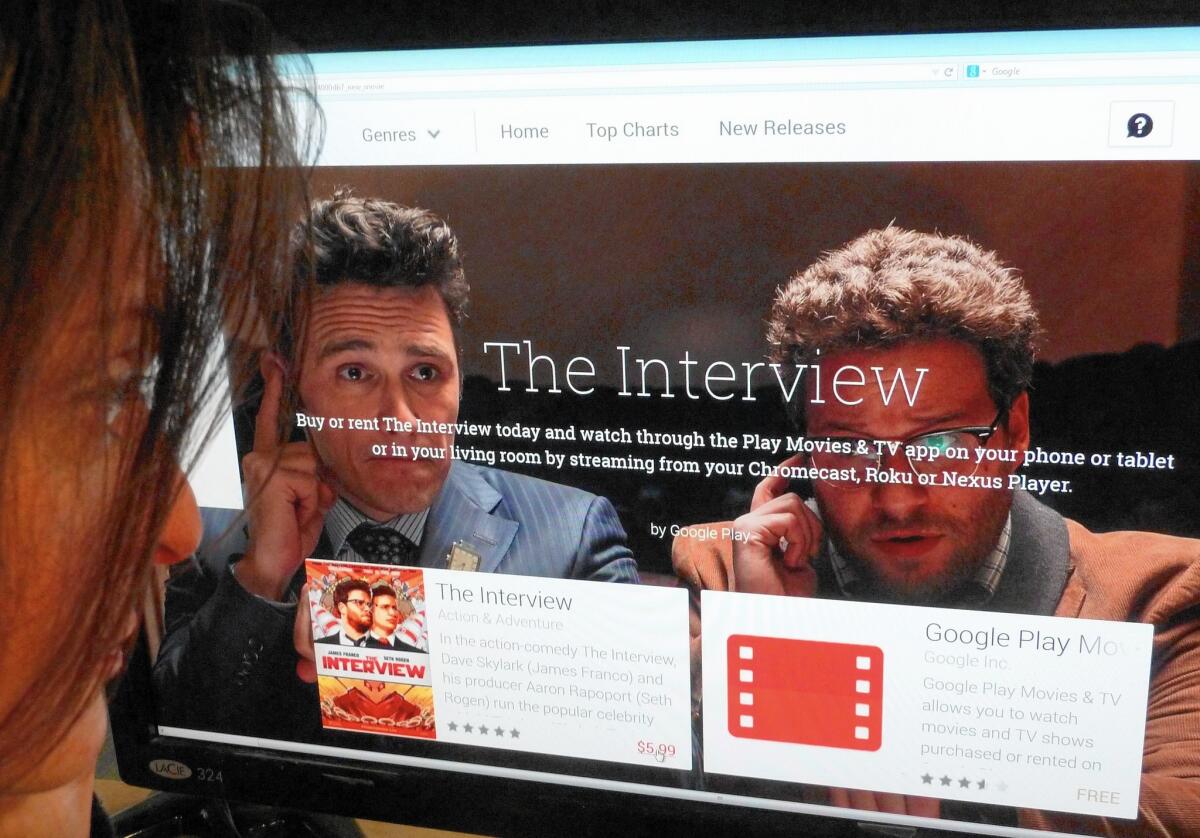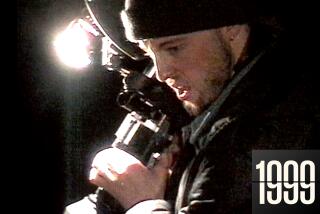VOD success of âInterviewâ could make online film releases more common

âThe Interviewâ wasnât supposed to change the way Hollywood movies are released. But perhaps the most lasting effect of the raunchy comedy could be in the way Americans go to the movies â or donât.
The farce at the center of a crippling cyberattack on Sony Pictures Entertainment unwittingly became the highest-profile example of a film debuting online at the same time it hits theaters.
Benefiting from unprecedented publicity, âThe Interviewâ took in an eye-catching $15 million in its first four days of online sales and rentals, more than five times its box-office tally over the holiday weekend.
That makes âThe Interviewâ one of the most successful online releases ever for a Hollywood movie â and could accelerate the film industryâs transition to a future in which moviegoers choose whether they want to see the latest films at the multiplex, or from their sofas.
âThe old chestnut was that you needed a theatrical release to establish legitimacy,â said consultant and former Columbia Pictures executive Peter Sealey. âThat old chestnut is dead now. They [Sony] have stumbled into the future.â
The advent of high-speed streaming services and wide-screen, high-definition televisions has created a ready market for so-called day-and-date releases, or making films available for home viewing at the same time as theaters.
Lionsgateâs 2012 day-and-date movie âArbitrageâ generated about $14 million in revenue from video on demand. Other films have done well with similar release patterns, including this summerâs dystopian thriller âSnowpiercer,â which generated $8.3 million in video-on-demand sales.
But industry executives could not recall a mass-market comedy such as âThe Interviewâ ever released on VOD so close to the beginning of its theatrical run.
Sony cobbled together its experimental unveiling after most theater chains declined to show the movie in the face of threats of terror attacks on theaters from a group calling itself Guardians of Peace, which claimed credit for the cyberattack on the studio. Federal officials have linked the cyberattack to North Korea, angered over the filmâs fictional assassination of leader Kim Jong Un, but authorities have said the terror threats were not credible.
For the studios, the chance to release films simultaneously in theaters and through video on demand is an opportunity to reach younger tech-savvy audiences, and offset declines in the once-lucrative DVD business.
The economics of digital distribution work well for studios, which get to keep a bigger portion of the sales from video on demand. Movie studios keep 70% to 80% of the VOD revenue, whereas theater companies get roughly half of the money generated from ticket sales.
Theater chains see things differently. They have resisted efforts to shorten the window between theatrical and home release, which is currently about 120 days, down from 150 a decade ago, according to the National Assn. of Theatre Owners. They fear that showing movies in the home close to when they arrive in theaters will keep consumers away from the big screen.
Bow Tie Cinemas, which operates 55 theaters in New York, New Jersey and several other states, was among the companies that refused to screen âThe Interviewâ because of the VOD release.
âItâs always been the nature of our business that we enjoy exclusive access to these films prior to their release in the home video market,â said Joe Masher, chief operating officer for Bow Tie Cinemas. âWeâre standing strong with our brethren in protecting that.â
Theaters still generate the biggest bang for studios. The $15 million that âThe Interviewâ generated from digital sales and rentals over the Christmas weekend might have equated to about $25 million if the film had been released on 3,000 screens, as Sony originally planned.
The movie, which cost $44 million to make, ended up in 331 theaters and pulled in $2.8 million in ticket sales through Sunday.
âThe Interviewâ was streamed or downloaded more than 2 million times over the holiday weekend after it was released on Google Play, YouTube Movies, Microsoftâs Xbox Video and a stand-alone website on Christmas Eve, the day before it hit theaters. The film cost $5.99 to rent and $14.99 to buy.
Precise comparisons with other day-and-date releases are difficult because studios release such information selectively, but industry analysts say âThe Interviewâ is perhaps the biggest success of its kind yet â albeit one helped by a constant stream of news stories about the Sony hack.
âThis was a special case, but it showed what it could be,â said a senior studio executive who requested anonymity because of the sensitivity of the topic. âBut just putting one movie up there is not going to change consumer behavior.â
To be sure, not all studio executives favor abandoning the traditional distribution model.
Studios have reaped huge financial rewards by releasing their movies through a series of markets that force people to pay each time they want to see a film: first in theaters, months later on DVD, followed by video on demand and on cable channels such as HBO or Starz.
Piracy is also a concern for studios when it comes to day-and-date releases. Bootlegged copies of âThe Interviewâ began showing up online almost immediately after its VOD release, and people downloaded the film via file-sharing websites 1.5 million times in the first two days of its release, according to the website Torrent Freak.
BTIG analyst Rich Greenfield said the strategy can work well for films that target a niche audience and cost less to make than the typical Hollywood blockbuster, but it remains to be seen if such a rollout can work for major Hollywood movies. Still, the $15-million online rollout for âThe Interviewâ is âencouraging,â Greenfield said. âIt shows that when you make content available in an earlier window in the home, people will pay to watch it.â
Times staff writers Saba Hamedy, Meg James and Richard Verrier contributed to this report.
More to Read
From the Oscars to the Emmys.
Get the Envelope newsletter for exclusive awards season coverage, behind-the-scenes stories from the Envelope podcast and columnist Glenn Whippâs must-read analysis.
You may occasionally receive promotional content from the Los Angeles Times.











